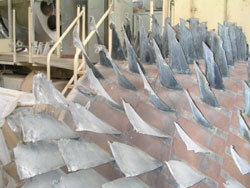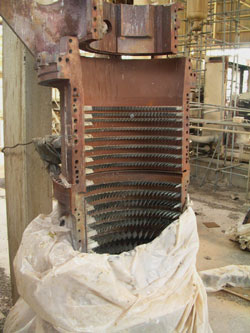 1. Switchyard of the Doura power plant in
its "as found" condition.
1. Switchyard of the Doura power plant in
its "as found" condition.Courtesy: Tom Sawyer, ENR
"Let's get the lights on!"
Most experts agree that Iraq's power generation equipment and electrical grid was in far worse shape than prewar estimates and that it broke down completely amid postwar looting and sabotage. Twenty years of neglect had already driven the power infrastructure to the brink of collapse before the first bombs fell on Baghdad. Electricity is a country's lifeblood, and restoring power in Iraq is the first step in moving the country off life support.By Tom Sawyer, Engineering News Record
Restoring power to Baghdad—and the rest of Iraq—is like setting up lines of dominos that, once tipped, should cascade into ever-widening circles of service. Electric power puts water and wastewater treatment plants and
 1. Switchyard of the Doura power plant in
its "as found" condition.
1. Switchyard of the Doura power plant in
its "as found" condition.Courtesy: Tom Sawyer, ENR |
refineries back to work and takes critical facilities such as hospitals and food-processing operations off the life support of emergency generators. In short, restoring electrical service will jolt Iraq's economy back to life.
Aside from three major power plants and a host of substations, many of which have limited generating capacity of their own, Baghdad has around 65 hospitals, 10 water treatment plants, and three major wastewater treatment plants inside city limits (see map on page 54). It also has a key refinery close by and a number of major food-processing facilities that require power from the system. Iraq's 400-kV transmission system links hydroelectric, gas-fired, and oil-fired plants across the country to the heart of the system in Baghdad. Distribution in cities is at 132 kV.
"We made a point during the conflict to not take down the infrastructure of the country," said Brig. Gen. Steven Hawkins. "But you have to remember that when the fighting began [Iraq's electricity system] was running at only 71% of its pre-1991 [capacity]." Hawkins is heading a task force coordinating critical services restoration. Called Fajir, Arabic for first light or dawn, this task force is organized under Combined Joint Task Force 4, a combined-services, multinational effort to restore vital services to Iraq.
 2. Repair work. One of the first orders of business was to repair damaged switchyard components and replace copper wire looted from the Doura plant. Courtesy: Tom Sawyer, ENR |
"We will help bring everybody here if we know who to bring," said Hawkins at a daily meeting point established in the neutral confines
of Baghdad's Doura power plant. Doura is nominally the largest generating station in the city, but only one of its four 160-MW units was functioning before the war—and only at about half of its rated capacity. "Being an engineer, that's what I want to do. Politicians do politics. I want to get the country running. Let's get the lights on!" Hawkins said.
"We're very glad to work and restore the power for ourselves and our families," said Raad Al-Haris, project manager at the Yosifiya Power Station, a Russian-built plant under construction in Baghdad. "We're not working for the military; we're working for civilians," he says.
Iraqi engineers are making great progress in restoring power, but their first concern is the security of their installations, transmission lines, and personnel. They also want to inspect key substations and transmission lines and verify the integrity of the fuel supply network. Although fuel supplies are low, the long-term delivery system must be restored. The engineers say their oil-fired units can burn a wide variety of fuels.
One approach used for restoring power involved starting up service to about 500,000 customers in central Baghdad. That approach either pulls power generated by the gas/oil-fired turbines at the Baghdad South and Doura generating stations in or near the city, or
 3. Backup generators installed by the Army Corps of Engineers at Doura. Courtesy: Tom Sawyer, ENR |
draws it from gas turbines at several small transmission stations scattered around the city. But transmission links must be verified in a city where shots, firefights, and explosions occur with unnerving frequency.
A more-robust approach to restoring power would be to bring electricity to the city over one or more of the 400-kV transmission lines leading from hydroelectric, oil-fired steam, or gas turbine facilities in Mosul, Baygi, and Kirkuk. In most cases, the generating facilities were undamaged, but the condition of the transmission lines leading from them remains a big unknown. That alternative also is attractive to planners, because hydropower generation has no fuel-supply problems.
Iraqi engineers who have been scouting the condition of their equipment and transmission lines within the city say it is "not so bad," although some important facilities and tools have been vandalized or stolen. A missing high-bucket crane with a 90-ft boom, for instance, may be needed to restore high transmission lines. The Army has offered the Iraqis use of a 45-ft crane with no bucket while it helps them look for their missing long-boomed crane.
Fortunately, war damage to the plants and transmission grid was limited. The biggest problems continue to be those engendered by security problems at lines, transmission stations, and generating facilities—as well as the technical issues raised by more than a decade of improvised repairs and neglect.
  3. Backup generators installed by the Army Corps of Engineers at Doura. Courtesy: Tom Sawyer, ENR |
—Tom Sawyer was formerly embedded with the U.S. Army's Third Infantry
Division, Engineer Brigade.
Copyright © 2004 - Platts, All Rights Reserved